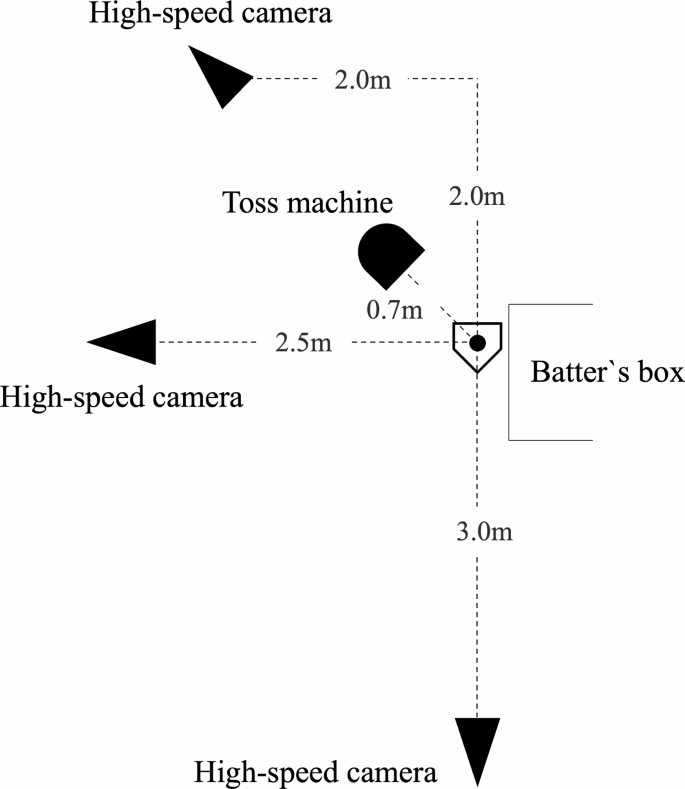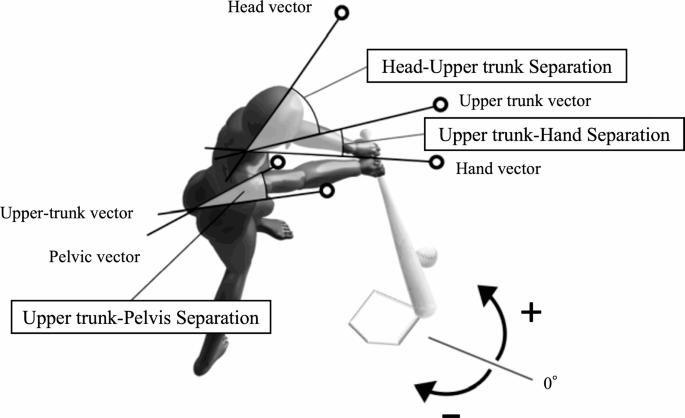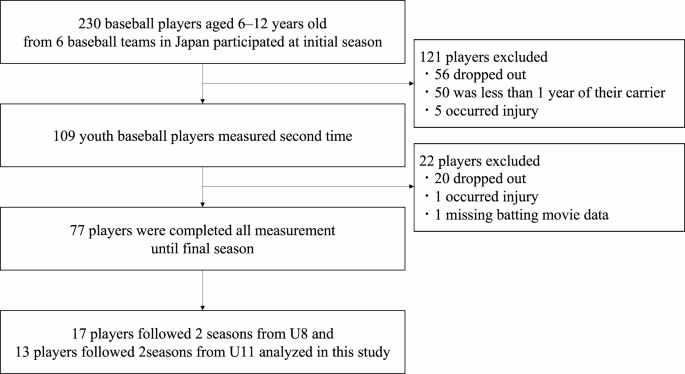
[ad_1]
Members
We initially recruited 230 junior baseball gamers from six groups in Tokyo, Japan in April 2018. The inclusion standards had been males aged between 6 and 12 years. The exclusion standards had been harm and sickness that prevented the measurements of the participant. Members had been categorized by age teams throughout the baseball season in keeping with the little league eligibility guidelines—gamers had been categorized in keeping with age as of July 31 of a given yr. Subsequent, the interval as much as July 31 of the second grade of elementary college was outlined as Beneath 8 (U8), and after that, the interval was divided by yr as much as U13. They performed and practiced baseball for 3–6 h a minimum of twice per week (Saturdays and Sundays). Earlier than the examination, all members accomplished an information questionnaire requesting the next data: start, age after they first began enjoying baseball, and the aspect on which they bat. Moreover, all members and their guardians acquired an in depth clarification of the experimental procedures and dangers of the analysis earlier than measurements had been carried out. Furthermore, written knowledgeable consent was obtained from all members and their guardians who assented to the examine. This examine was authorised by the Ethics Committee of the Waseda College (No. 2018 − 208).
Batting process
Testing was performed between 09:00 and 16:00 at an out of doors baseball subject maintained underneath normal environmental circumstances. As well as, testing was performed between January and March, divided into 4 to six days per season. First, we measured the participant`s top and weight with their garments on. Subsequent, with out their sneakers on, top was measured to the closest 0.1 cm with out their sneakers on utilizing a stadiometer (YG200DN, Yagami Co., Nagoya, Japan); and weight was measured to the closest 0.1 kg utilizing a digital scale (BC622, TANITA Co., Tokyo, Japan). Subsequent, the batting trial was carried out after easy warm-up workouts, together with dynamic stretching, jogging, mild throwing, and swinging for roughly 20 min. Every participant acquired non-reflected white markers on the highest of the pinnacle, each lateral acromion suggestions, and anterior and superior iliac spines. The trial concerned toss batting with an automated toss machine (FTM-240; Area Power Firm, China). The toss machine was positioned 0.7 m from the middle of the house plate on the other aspect of the batter and 1.1 m towards the pitcher; it was positioned to launch obliquely in entrance of the batter. The peak of the tossing machine was adjusted in keeping with the participant’s top as follows: 45% of the peak minus 52.5 cm. Then, precise testing was carried out twice after one observe try, and the batting movement was captured at 240 Hz with three high-speed cameras (Ex-100PRO, Casio Co., Tokyo Japan) positioned on the batter’s aspect, again, and entrance (obliquely). The atmosphere of the batting trial setting was proven in Fig. 1.
Moreover, the swing velocity—a part of the batting efficiency was measured utilizing a Zepp sensor (ZEP-BT-000002; Zepp Firm, Cupertino, California, USA), which has been proven to have excessive reliability (ICC, 0.88) [13], and indicated to correlate reasonably to strongly with knowledge analyzed by 3D movement seize [14]. Members had been allowed to reattempt the batting trial in the event that they missed the ball whereas swinging or made timing errors. Throughout the batting trial, members used the bat they’d usually use in baseball observe and video games and constantly used the identical bat all through their trials. Knowledge had been collected from the check with the very best swing velocity.
Variables
The rotation angles of the pinnacle, higher trunk, pelvis, and arm course within the horizontal aircraft throughout the batting movement and the separation angle between every phase, the quantity of head motion, and the step width had been analyzed by guide digitizing utilizing a movement evaluation system (Body-Dias V; DKH, Tokyo, Japan). Furthermore, we visualized the physique markers connected to the pinnacle, each lateral acromion suggestions, anterior and superior iliac spines, nostril, toes, and the midpoint between each fingers on the bat on the display utilizing a digital format. Subsequent, three-dimensional coordinates had been obtained utilizing the direct linear transformation technique [15], and the right-hand orthogonal reference body was outlined because the X-axis, Y-axis, and Z-axis. The Y-axis was directed from the pitcher’s mound to the house plate, and the Z-axis indicated a vertical course (backside to prime). Moreover, the X-axis was outlined because the cross-product of the Y-axis and Z-axis. For calibration, poles with 9 markers (from 0 to 2.0 m at 25 cm intervals) had been vertically set in a 4 × 4 grid at 40 cm intervals (the usual errors had been as follows: x = 0.22 cm; y = 0.28 cm; z = 0.34 cm). A recording of the calibration factors utilizing the three high-speed cameras was performed from the begin to the tip of batting. The evaluation knowledge had been collected at 5 factors: stance, load, foot contact, pre-swing, and ball contact. Stance and foot contact had been outlined as the purpose of the toe of the stepping leg on the Z-axis at which the worth of the Z-axis started to extend within the constructive course. Furthermore, load and pre-swing had been outlined because the midpoints between stance and foot contact and between foot contact and ball contact, respectively.
All rotation angles had been calculated utilizing values akin to areas in world coordinates as a result of batting is an operation initiated by reacting to a thrown ball and outlined because the projected angle on the horizontal aircraft concerning the X-axis (Fig. 2). Moreover, the rotation angles had been set as constructive/unfavorable towards the pitcher/catcher.
The variables analyzed on this examine and their definitions are as follows:
-
Head rotation—the angle between the pinnacle vector (prime of the pinnacle to the nostril) and the X-axis.
-
Higher trunk rotation—the angles between the higher trunk vector (passing by means of the midpoint of each acromions and perpendicularly to the road connecting each factors) and X-axis.
-
Arm course—the angle between the hand vector (midpoint of each acromions to a degree between each fingers) and the X-axis.
Moreover, the separation angle was expressed because the distinction between every rotation angle, and head-to-upper trunk separation was calculated by subtracting the pinnacle rotation from the higher trunk rotation. Furthermore, higher trunk-to-arm separation was calculated by subtracting the higher trunk rotation from the arm course. Higher-to-pelvis separation was calculated by subtracting the higher trunk rotation from the pelvis rotation. The linear head motion distance (head motion) from stance to foot contact and foot contact to ball contact was calculated because the ensuing displacement of the highest of the pinnacle. Lastly, the stance widths throughout stance and foot contact had been calculated as the gap between the toes.
Statistical evaluation
A statistical energy evaluation was performed for pattern measurement estimation. We required greater than 12 gamers for this examine to conduct a comparability of the three teams at 80% energy, an alpha of 0.05. and a partial η of 0.14. Seventy-seven baseball gamers who met the inclusion standards accomplished three measurements for 3 seasons. Of those, 17 gamers shaped group 1 (U8 to U10), and 13 shaped group 2 (U11 to U13) (Fig. 3).
Descriptive statistics (imply ± normal deviation) had been carried out. After confirming all knowledge had been usually distributed utilizing the Kolmogorov–Smirnov check and confirming homoscedasticity with Levene’s check, we carried out a one-way repeated measures evaluation of variance (ANOVA) to match chronological age, top, physique weight, competitors years, rotational and separation angles, swing velocity, head motion, and step width on the factors of stance, load, foot contact, pre-swing, and ball contact among the many preliminary, second, and last measurements for 3 seasons. Moreover, we carried out a number of comparisons of the technique of the monitored variables utilizing the Bonferroni check. Partial η2 was calculated for the impact measurement of the one-way ANOVA, with values of ≥ 0.01 to < 0.06, ≥ 0.06 to < 0.14, and ≥ 0.14, indicating small, medium, and huge results, respectively [16]. Lastly, the alpha degree was set at 0.05 and all statistical analyses had been carried out utilizing SPSS Statistics 27.0 (IBM, Armonk, New York, USA).
[ad_2]
Supply hyperlink


